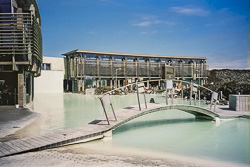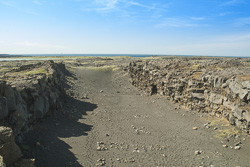The Reykjanes peninsula
The Reykjanes peninsula is situated southwest of Reykjavik. About 31,000 people (ca. 8% of the population) are living here, most of them at the north coast of the peninsula. 
Those who arrive in Iceland by aeroplane, gain a first impression of Iceland on the drive from the airport to Reykjavík. In comparison to other areas, the peninsula Reykjanes has hardly been made available to tourism although one can find some interesting villages here. Below you'll find some basic information on Reykjanes. Further sights and attractions are available in our photo gallery.
The Blue Lagoon
Iceland’s most famous bathing place is the Blue Lagoon, a few kilometres north of Grindavík. Since 1978 the geothermal power plant supplies the airport and surrounding villages with hot water and electricity. The salt base, extracted from a depth of 2,000 metres, is used to heat freshwater. The saltwater is lead into an adjacent dike, which forms the Blue Lagoon. By now, this is commercialised as a tourist attraction and currently registers more than 200,000 bathers annually. Additionally, a health resort has been erected in the neighbourhood. The mineralised water of the laguna has a healing effect on skin diseases, as for example psoriasis. Also skin care products have been brought onto the market and are available in every gift shop. In 1999 the Blue Lagoon has been moved by several hundred metres and the institution has been modernised.
Round trip Reykjanes

on Reykjanes peninsula
The peninsula Reykjanes though has more places of interest to offer. It is located in Iceland’s active volcano region. Therefore, more hot water springs and solfatara fields can be found here, like for example near Krýsuvík, from where some hikes can be undertaken.
The west coast of the peninsula is also interesting. A specious avifauna can be observed close to the lighthouse in the southwest. A few kilometres further north one comes across the rips of the Mid-Atlantic-Ridge, which ascends out of the ocean here and "goes onto land".
Eldey
About 21 kilometres south west of the peninsula Reykjanes the ”Fire Island” eldey rises out of the sea. This rock with its 70 metres high cliffs is not accessible for tourists. It accommodates the largest northern gannet colony in the world. Up to 40,000 birds of this species nest here.
Also for the flightless Great Auk this little piece of land was a favourite nesting place. After the species had already been extinguished in Canada, Greenland and on the Faroe Islands, Iceland was the last refuge. However, the world wide last two birds of the extincted Great Auk were killed in 1844 on the island of Eldey. The island is not accessible for visitors. In good weather conditions, however, one can see it as a big rock in the sea from the west and south side of the Peninsula Reykjanes. In 1974 Eldey was put under conservation.

